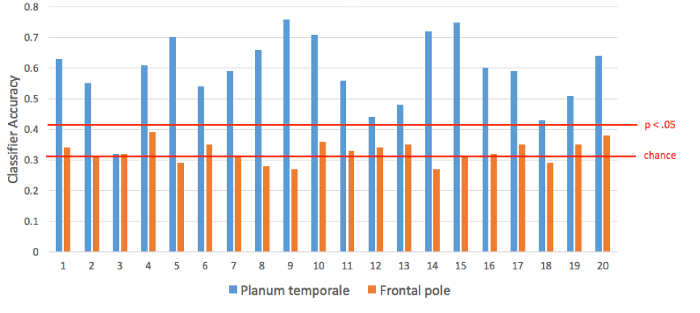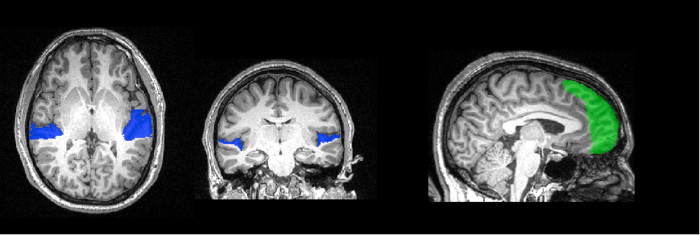Descodificación de imágenes auditivas con análisis Multivoxel
Visión general
Fuente: Laboratorios de Jonas T. Kaplan y Sarah I. Gimbel, University of Southern California
Imagine el sonido de un timbre de campana. ¿Lo que está sucediendo en el cerebro cuando nos evocan un sonido como este en el "oído de la mente"? Hay creciente evidencia de que el cerebro utiliza los mismos mecanismos de imaginación que utiliza para la percepción. 1 por ejemplo, al imaginar imágenes visuales, se activa la corteza visual, y cuando imaginar sonidos, la corteza auditiva se dedica. Sin embargo, ¿hasta qué punto son estas activaciones de cortezas sensoriales específicas al contenido de nuestra imaginación?
Una técnica que puede ayudar a responder a esta pregunta es multivoxel análisis (MPVA), en cuyas imágenes funcionales del cerebro se analizan utilizando técnicas de aprendizaje máquina. 2-3 experimento en un MPVA, formamos un algoritmo de aprendizaje automático para distinguir entre los diferentes patrones de actividad evocada por estímulos diferentes. Por ejemplo, nos podríamos preguntar si imaginar el sonido de una campana produce diferentes patrones de actividad en la corteza auditiva en comparación con imaginando el sonido de una motosierra, o el sonido de un violín. Si nuestro clasificador aprende a diferenciar los patrones de actividad cerebral producidos por estos tres estímulos, entonces podemos concluir que la corteza auditiva se activa de forma distinta por cada estímulo. Una forma de pensar de este tipo de experimento es que en lugar de preguntar simplemente sobre la actividad de una región del cerebro, nos pregunta sobre el contenido de información de la región.
En este experimento, basado en Meyer et al., 2010,4 nos se cue los participantes a imaginar varios sonidos presentándoles videos silencio suelen evocar imágenes auditivas. Ya que estamos interesados en la medición de los patrones sutiles evocados por la imaginación en la corteza auditiva, es preferible si los estímulos se presentan en completo silencio, sin la interferencia de los ruidos hechos por el escáner de fMRI. Para lograr esto, usaremos un tipo especial de secuencia de MRI funcional conocida como escaso muestreo temporal. En este enfoque, un volumen único fMRI es adquirido 4-5 s después de cada estímulo, para capturar el pico de la respuesta hemodinámica.
Procedimiento
1. participante reclutamiento
- Reclutar a 20 participantes.
- Los participantes deben ser diestros y no tienen antecedentes de trastornos neurológicos o psicológicos.
- Los participantes deben tener visión normal o corregida a normal para que sean capaces de ver los indicios visuales correctamente.
- Los participantes no deben tener metal en su cuerpo. Se trata de un requisito de seguridad debido al alto campo magnético en fMRI.
- Participantes no debe sufrir de claustrofobia
Resultados
La precisión del clasificador promedio en el planum temporale en todos los 20 participantes fue del 59%. Según el test de Wilcoxon Signed-Rank, esto es significativamente diferente del nivel de probabilidad del 33%. El rendimiento medio de la máscara frontal del poste fue 32,5%, que no es mayor que la probabilidad (Figura 2).

Figura ...
Aplicación y resumen
MVPA es una herramienta útil para comprender cómo representa el cerebro la información. En lugar de considerar el curso del tiempo de cada voxel por separado como en un análisis tradicional de activación, esta técnica considera patrones en vóxeles muchas a la vez, ofreciendo una mayor sensibilidad en comparación con las técnicas univariantes. A menudo un análisis multivariado revela diferencias donde no es capaz de una técnica de análisis univariados. En este caso, hemos aprendido algo acerca de los mecanismo...
Referencias
- Kosslyn, S.M., Ganis, G. & Thompson, W.L. Neural foundations of imagery. Nat Rev Neurosci 2, 635-642 (2001).
- Haynes, J.D. & Rees, G. Decoding mental states from brain activity in humans. Nat Rev Neurosci 7, 523-534 (2006).
- Norman, K.A., Polyn, S.M., Detre, G.J. & Haxby, J.V. Beyond mind-reading: multi-voxel pattern analysis of fMRI data. Trends Cogn Sci 10, 424-430 (2006).
- Meyer, K., et al. Predicting visual stimuli on the basis of activity in auditory cortices. Nat Neurosci 13, 667-668 (2010).
Saltar a...
Vídeos de esta colección:

Now Playing
Descodificación de imágenes auditivas con análisis Multivoxel
Neuropsychology
6.5K Vistas

El cerebro dividido
Neuropsychology
68.5K Vistas

Mapas de motor
Neuropsychology
27.7K Vistas

Perspectivas de la neuropsicología
Neuropsychology
12.2K Vistas

Toma de decisiones y la Iowa Gambling Task
Neuropsychology
32.9K Vistas

Función ejecutiva en el trastorno del espectro autista
Neuropsychology
18.0K Vistas

Amnesia Anterógrada
Neuropsychology
30.5K Vistas

Correlatos fisiológicos de reconocimiento de la emoción
Neuropsychology
16.4K Vistas

Potenciales acontecimiento-relacionados y la tarea de Oddball
Neuropsychology
27.6K Vistas

Idioma: La N400 en incongruencia semántica
Neuropsychology
19.7K Vistas

Aprendizaje y la memoria: la tarea de recordar-sabe
Neuropsychology
17.3K Vistas

Medición de las diferencias de materia gris con Morfometría basada en Voxel: el cerebro Musical
Neuropsychology
17.4K Vistas

Atención visual: fMRI Control atencional basado en la investigación del objeto
Neuropsychology
42.2K Vistas

Utilizando imágenes de Tensor de difusión en la lesión cerebral traumática
Neuropsychology
16.9K Vistas

Uso de TMS para medir la excitabilidad motora durante la observación de la acción
Neuropsychology
10.3K Vistas
ACERCA DE JoVE
Copyright © 2025 MyJoVE Corporation. Todos los derechos reservados
